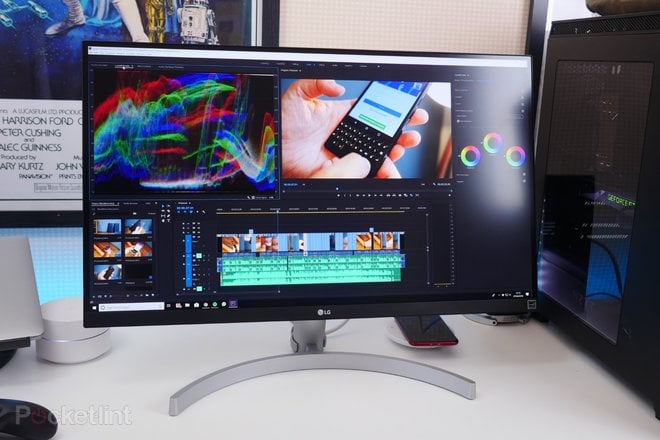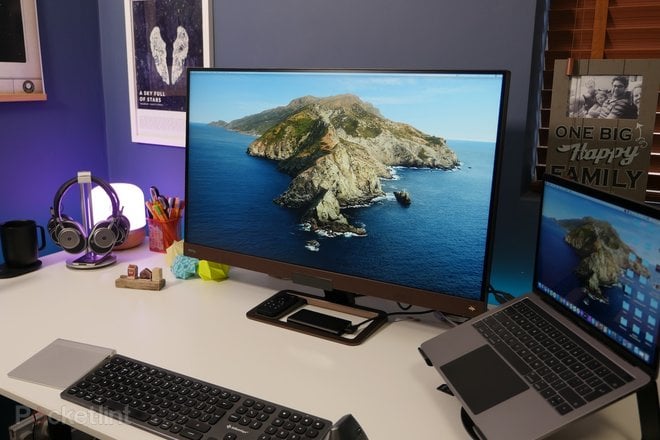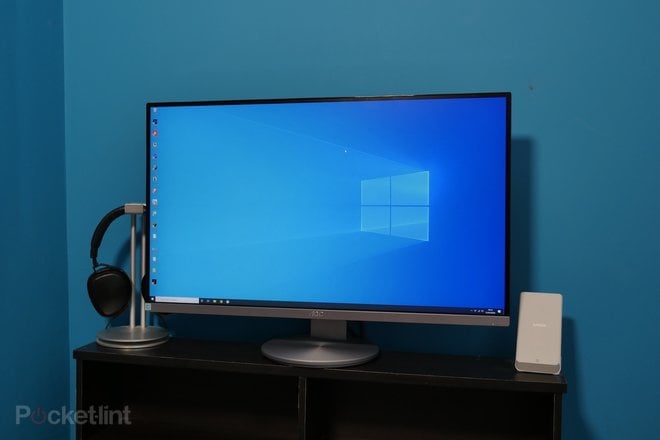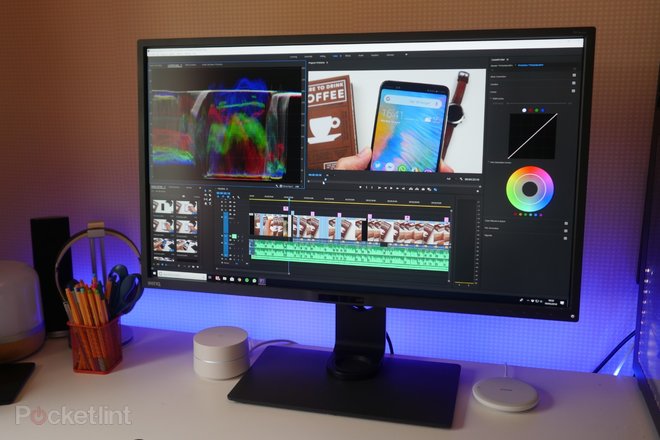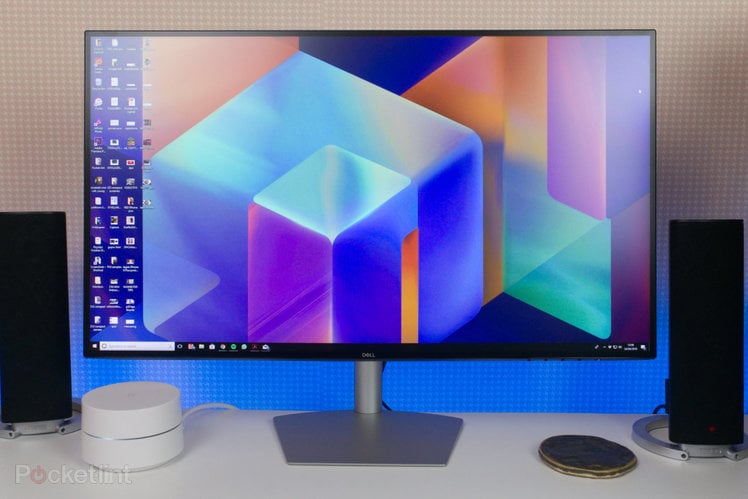
Whether you have a monster PC, a MacBook or just an everyday use-it-for-everything computer, there are many reasons why you’d need a monitor.
That also means there are many things to consider when looking to buy one.
For some, only the biggest and sharpest panel will do. For others, it’s fast refresh rates for smooth visuals.
Whatever your reason for wanting a monitor, we’ve tested and rounded up some of the best monitors for all purposes available right now.
Best everyday QHD
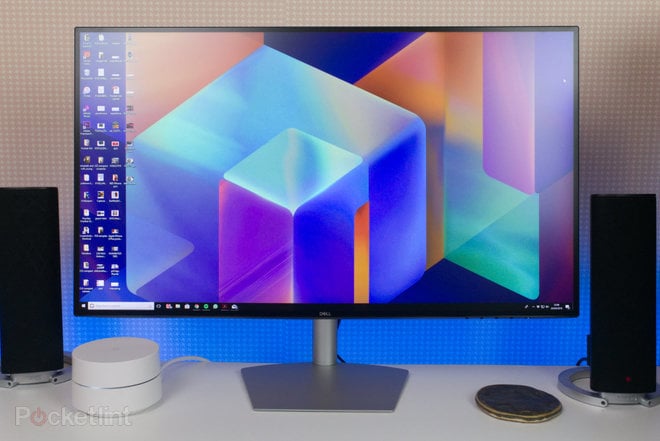
Dell Ultrathin S2719DM
- Quad HD (2560 x 1440) 16:9
- 27-inch LED backlit IPS LCD
- 60Hz + AMD Freesync
- 600 nit brightness
- Up to 5ms response time
- HDR-ready (HDR400)
Over the past couple of years, Dell has made a name for itself in the world of laptops for designing some of the best-looking devices around. In the same time frame, it’s also applied this same approach to monitors. The Ultrathin series is a fine example of stylish, minimalist design for around £320 or $329. This does mean some compromises though, so we’ll get those out of the way first.
Because it has a slim, sleek metal stand, you don’t get as much movement or adjustment out of it as you might from a big, plastic thing with lots of moving parts. You can adjust the angle of the screen to make it as comfortable as possible, but you can’t raise or lower it, and you can’t swivel it. That means – if you’re tall – you can’t have the monitor at eye level, although we found with the ability to tilt the screen backwards, we could get it angled enough to be pretty comfortable to use.
The other downside to this particular slim, attractive design is that there isn’t a lot of room for rows of extra ports. In this instance, you get two HDMI ports, a single 3.5mm output and the power input. Nothing else.
As a monitor, it’s great, especially for those looking for something simple, capable and stylish to complement their minimal desk setup. While it’s not as pin-sharp as 4K, there’s plenty of detail in the Quad HD resolution panel, and with the configuration options available – and easily controllable through the four button system – you can get it looking really good. IPS LCD based tech also means you get good viewing angles too.
It’s HDR-ready, for content that supports that which, although not as dynamic or apparent as HDR on a good 4K TV, still means this monitor is just as great for watching the occasional movie as it is for editing your photos, getting work done or editing video. It’s a truly great allrounder, it looks classy and doesn’t cost the earth.
Even for gamers, the 60hz, 5ms response time and AMD Freesync means it’s a capable gaming monitor too, even if it’s not quite up there with the super fast, G-sync driven displays out there. Those wanting really fast response times and Nvidia GPU optimisation will want to look elsewhere, but for the casual gamer, it’s just fine.
As a bonus, for those who have a particular interest in environmental impact, Dell’s monitors are among the very few that ship with predominantly cardboard packaging, both inner and outer. There’s no chunky polystyrene anywhere to be seen.
Sure, we’d prefer it if it had a Thunderbolt port or a Displayport input, but as an all-rounder, it’s hard to criticise too much.
Best everyday 4K
LG 27UK600
- 4K UHD (3840 x 2160) 16:9
- 27-inch LED backlit IPS
- 60Hz + AMD Freesync
- 450 nit brightness
- HDR support
- Up to 5ms response
If what you’re after in a monitor is a standard 16:9 ratio screen in an attractive package that’s as accurate as it is sharp, LG’s 27-inch 4K monitor is a great shout that’s priced at $567 or £398.
Getting possibly the only two downsides out of the way first: The stand doesn’t move up and down, it’s fixed, so you can’t adjust the height to be at a more ergonomic level without putting it on top of a raised surface of some kind. Secondly, it doesn’t have the most generous number of ports we’ve ever seen on a monitor.
While the stand height isn’t adjustable, the screen can be tilted between minus 5-degrees to 15-degrees to ensure there’s at least some adjustment there. We feel, perhaps, part of these design choices were down to cost cutting. To get a great 4K resolution panel in a monitor under £400, some compromises had to be made somewhere.
Apart from that, the mostly all-plastic design is pretty attractive. It’s subtle, minimal and we like the silver curved base and the slim bezels around the actual display.
At 27-inches, the screen itself isn’t too big or too small, it’s a good size, and the quality of the panel is pretty surprising at this price point. It’s an IPS panel, so viewing angles are tremendous, and we found colours, contrast and details to be really well balanced across the board. It made a great panel for editing photos and video on.
Its frequency response and frame rates (5ms and 60Hz respectively) it’s not the most highly tuned for gaming, but with the addition of AMD’s Freesync, it’s certainly good enough for all but the most extreme gamers. We tested it on a couple of games running at ultra visual settings (again using the 1080Ti GPU) and found very little to be dissatisfied with.
Now, while it claims to offer HDR support, it’s much like most other monitors we’ve tried so far, in that it actually isn’t true HDR. With the screen’s peak brightness of just 450 nits, you don’t get close to the full HDR effect you’d get from a proper HDR 1000+ nits TV. Still, it’s as great a panel for watching movies on as it is everything else.
There are so many preset modes to choose from, ranging from various gaming modes to photo editing, movie watching and so on, that it’s foolish to try and list them all. What’s more pleasing here is that you select and customise your screen’s callibration using the one single joystick at the bottom of the monitor. It’s so easy to control. Every monitor should work this way.
Back to those ports we mentioned earlier, and what it lacks in quantity, it makes up for in capability. There are two HDMI 2.0 inputs, both support HDR sources and both can delivery 4K at 60Hz. Similarly, there’s a DisplayPort input of the same specification. The only other connector – apart from the power input – is the 3.5mm jack.
That means, sadly, you can’t use it as a USB hub of sort. It’s a display only. But, it is a very good one that won’t cost you an absolute fortune.
Best everyday ultrawide?
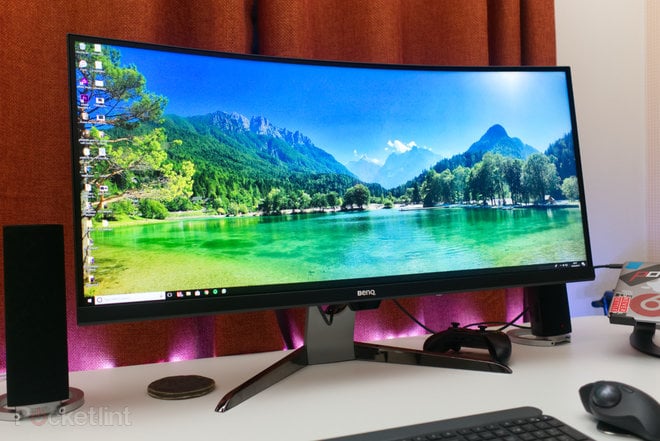
BenQ EX3501R
- Ultrawide 3440 x 1440
- VA panel + HDR
- AMD FreeSync
- 1800R Curved
- Type-C port
If you’re after an all-round great ultrawide panel for content creation, media consumption, MacBook use, gaming and everything in between it’s hard to look past the BenQ EX3501R. It’s big, looks professional, feels solid and offers a great experience regardless of what you want to use it for, costing $849 or £625.
One thing we really like about the BenQ is that even if it does have some impressive specs that make it ideal for gamers – particularly those using AMD graphics cards – it has plenty about it to make it great for just about any purpose.
For MacBook users there’s a USB 3.1 Type-C port, so you’ll only need that one compatible cable to make use of the monitor’s primary display function, as well as gain access to the USB 3.0 hub capabilities. So, simply plug in your MacBook and then use the two built in USB ports to connect any other peripherals.
For PC users, there’s both DisplayPort 1.4 and two HDMI 2.0 ports. In total then, that means you can connect up to four different devices, including your MacBook. Add that versatility to the sheer size and immersive viewing you get from the 35-inch curved panel, and the boosted contrast offered by its HDR capabilities and you get one impressive, big canvas. It’s worth noting, HDR doesn’t make as much of a difference here as it does on a big 4K television, but it certainly improves dynamic range.
As for other features, there’s plenty here to ensure it’s just as good for work as it is for play. The B.I.+ or Bright Intelligence Plus feature uses an onboard light sensor to adapt the screen’s brightness to match the surroundings. There’s also a blue light filter and flicker-free technology to help protect your eyes during long stints at the screen. The following picture modes are available:
- sRGB
- Gamer 1
- Gamer 2
- Gamer 3
- HDR
- Standard
- Photo
- Custom 1 & 2
- M-Book
Off all of those, the latter was the one we felt offered the best mix of colour vibrancy, clarity, brightness and contrast. However, there’s an endless amount of customisation here, and – as with any expensive monitor – it’s worth getting it calibrated properly using a purpose designed tool.
Although the AMD FreeSync is designed to ensure there’s no frame dropping or screen tearing/aliasing with AMD GPUs, we found the response time was fast enough that we were able to play games at 60fps with an Nvidia based GPU without any real issues. Details and speed were good.
Likewise, it made a great tool for editing video on long timelines thanks to the colour production and extra space granted by the ultra-wide ratio. We also like that it doesn’t look like a “gamer” monitor. The solid build, classy chromed feet and 60mm up-and-down travel ensured it looks good and is relatively adjustable. There’s no right/left movement, but with an 1800R curved monitor, you don’t tend to get that.
Best entertainment 4K
BenQ EW3280U
- 4K (3840 x 2160) 16:9
- 32-inch IPS LCD
- 60Hz + AMD Freesync
- 400 nit peak brightness
- Up to 5ms response time
- HDR-ready (HDR400)
- HDMI 2.0 and Type-C w/Power Delivery
If all you want in a monitor is for it to be a big, all-encompassing screen that does everything you need it to, the BenQ EW3280U is a truly brilliant option. It’s not curved, it’s just one big 32-inch 4K IPS monitor that the manufacturer bills as ideal for entertainment. That covers everything from sound, usability and the available ports.
On the back you’ll find a number of connectivity options. There are two HDMI 2.0 ports for fast action 4K input, as well as a DisplayPort connection and a USB Type-C port with included 60W Power Deliver output and DisplayPort capabilities. What that means, simply, is you can plug in your MacBook and have it charge while outputting the 4K 60Hz signal to the monitor all through one cable. And thanks to a neat cover behind the stand, cabling is really easy to tuck away out of site as well.
In theory then, you could have a streaming box/stick, PC, console and your laptop all connected to the monitor and once and then switch between them using the included nifty little remote control. And, given how good the speakers are on the monitor compared to pretty much every other monitor, you may even be happy to use it without any external audio equipment.
The visual experience is generally great too. Being a big panel, it’s not as pin-sharp as some smaller 4K ones, but being big also means you get a lot more real estate to work with which is useful if this is your only screen. It’s great for having multiple windows open, or working on video editing, and works just as well for watching movies or gaming. With so-called HDR, you can boost contrast and brightness further, but in our experience this option tends not to be as good as using it without HDR on. It appears over processed and not at all natural.
There are a lot of preset callibration modes though, including an option that closely matches the viewing experience to Apple’s MacBook settings. The only real downside to this entertainment monitor is that it’s not the most ergonomic solution in the world. Its stand doesn’t lift or lower, and the monitor only tilts slightly.
Best affordable 4K
AOC U2790PQU
- 4K (3840 x 2160) 16:9
- 27-inch IPS LCD
- 60Hz
- 350 nit peak brightness
- Up to 5ms response time
- USB 3.0 hub
AOC has long offered monitors that are great value for money, and the U2790PQU is no exception. It’s a great 4K monitor for working on thanks to a host of useful features and a sharp 4K panel.
Oddly, it’s probably the design that’s the best feature here. The stand is adjustable, so you can slide it up and down to raise or lower the height. Regardless of your eye height, you should easily be able to find an ergonomic level for you. Plus, the screen can be tilted between -5 and 45 degrees. More impressive though is the smoothly rotating base.. it allows you to turn the monitor, with the rubber base on the underside staying completely still and stable.
Being IPS LCD means the accuracy of the screen is good, and 4K means it’s plenty sharp enough for anyone. Plus, that 27-inch size is just about the sweet spot for people working from home, or at the office. It has slim bezels, giving it an almost edge-to-edge appearance too.
Best 4K monitor for creatives
BenQ PD3200U
- 4K UHD 3840 x 2160
- 10-bit, 100% sRGB, Rec.709
- 60Hz refresh
- IPS panel
If what you’re after is a big, sharp panel with great viewing angles, tonnes of flexibility, ergonomic design and brilliant colour accuracy, then look no further. The BenQ PD3200U is that monitor that costs $600/£700.
At 32-inches diagonally with the more standard 16:9 aspect ratio, you’re getting a big display without it being too enormous. Despite having 5 more inches diagonally, it doesn’t take up much more space than a 27-inch iMac, thanks to having slimmer bezels.
Its 4K UHD resolution IPS panel provides really sharp details and crisp text and looks good from almost any angle. Its impressive 10-bit 100% sRGB colour also means that your colours are going to look great too. It’s an ideal monitor for editing 4K video and working with graphics and photos. It’s not all about photos and video though, it has several preset calibrations designed for specific use cases:
- Rec. 709
- sRGB
- CAD/CAM
- Animation
- Standard
- Low Blue Light
- Darkroom
In each of those, brightness, contrast, colour balance and blue light filtering are adjusted to better suit the use cases they’re designed for. What’s more, with Dual View mode, you can have one side of the screen set up to one mode, and the other half calibrated for another. For instance, you could be working with a photo editor on one side, and a CAD drawing on the other.
Those working with more than one machine will be pleased to know that you can also have two computers connected at once and control them using the same keyboard/mouse combination using the KVM mode.
With all these plus points you’d assume there was some horrible compromise around the corner somewhere, but there really isn’t one unless you demand a design monitor that’s capable of keeping up with the ultra fast gaming monitors. At 60Hz, it’s not the fastest screen going, but we were still able to play games at 60fps reliably, using the Nvidia GTX 1080Ti card, and with resolution and rendering settings set to maximum. There was some minor stuttering here and there in Forza Horizons 3, but very rarely.
Then there’s the design and port offering, which only help increase our admiration of the monitor. The stand can swivel on its base 45 degrees to the left and to the right, and the screen can tilt from -5 to 20 degrees while also offering 150mm of height travel up and down. Oh, and if you want to, you can use it vertically.
Port wise, we’re looking at an array of useful inclusions. It has two HDMI 2.0 inputs as well as a DisplayPort 1.2 and mini DisplayPort 1.2. It’s got four USB 3.0 outputs as well as two USB type-B inputs, 3.5mm line in, 3.5mm line out and an SD card reader.
While it’s far from the cheapest monitor in the world, we think it still offers a lot of value and its qualities comfortably match that outlay.

